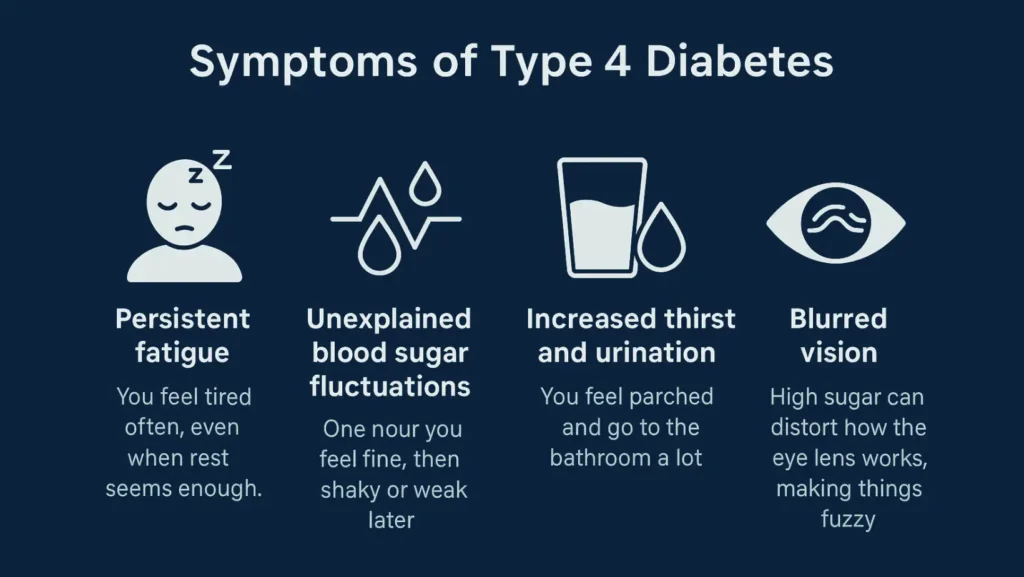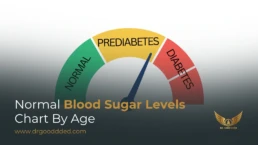Type 4 diabetes refers to a less common form of diabetes where your body resists insulin, yet you are not obese and your pancreas still produces insulin. This pattern looks like Type 2 but has unique causes, tests, and treatments.
Table of Contents
ToggleUnderstanding The Four Types Of Diabetes
When people talk about types of diabetes , they mostly mean Type 1 and Type 2 diabetes. But health experts sometimes include gestational diabetes and this newer concept, type 4.
There are many types of diabetes . The usual ones are:
- Type 1 , where your body makes little or no insulin.
- Type 2 , often tied to excess weight and insulin resistance.
- Gestational diabetes , which happens in pregnancy.
- And then there is Type 4 , less studied but real.
Type 4 diabetes is a pattern where insulin resistance arises without obesity, often influenced by aging or immune factors. Compared to Type 2, Type 4 does not rely on weight as a trigger. It blends features from immune issues and metabolic shifts.
What Causes Type 4 Diabetes?
Causes of Type 4 diabetes you should know about, and their several possible factors that work together.
Insulin Resistance Not Caused By Obesity
One clear cause is insulin resistance. Normally, insulin helps sugar enter your cells. In type 4, your blood sugar stays high because muscle, liver, or fat cells ignore insulin’s signal, but this happens even if you are not overweight. This is a subtle form of resistance.
Aging-Related Changes In Immune Function
As you age, your immune system changes. Some immune cells shift their behavior. These changes can reduce how well insulin works, even if you’ve never had weight problems.
Overactive Regulatory T Cells (Tregs) Reduce Insulin Sensitivity
Your body has immune cells called regulatory T cells (Tregs). They usually calm inflammation. But if these Tregs become overly active, they may alter signals in tissues and reduce insulin sensitivity. This immune twist can push someone into type 4.
Possible Genetic Or Metabolic Factors
Inherited genes can set the stage. Also, abnormal metabolism (how you break down fats, proteins, and sugars) can make your body less flexible in handling glucose. Low muscle mass, fatty liver, or altered fat tissue function may combine with genes and immune shifts to cause type 4 diabetes.
Symptoms Of Type 4 Diabetes
You might not look like someone with diabetes. But the diabetes symptoms can still appear. Watch for:
- Persistent fatigue: You feel tired often, even when rest seems enough.
- Unexplained blood sugar fluctuations: One hour you feel fine, then shaky or weak later.
- Slow healing wounds: Cuts or sores take much longer to heal.
- Increased thirst and urination: You feel parched and go to the bathroom a lot.
- Blurred vision: High sugar can distort how the eye lens works, making things fuzzy.
These symptoms may mimic Type 2, but their presence in a person without obesity is a clue to Type 4 diabetes .
How Is Type 4 Diabetes Diagnosed?
Because it appears similar to Type 2, doctors use tests and rules to uncover it.
Blood Glucose And A1C Tests
Your evaluation will include a fasting blood glucose test taken after not eating, along with random or post-meal readings. An A1C test is also done to measure your average blood sugar over the past three months. Together, these results help determine whether your values fall within the Normal Blood Sugar Level range or indicate diabetes.
Insulin Sensitivity Tests
Doctors may use methods to test how responsive your cells are to insulin. This assessment reveals resistance even if other factors seem normal.
C-Peptide Levels
C-peptide is a byproduct when insulin is made. Measuring it tells doctors whether your pancreas is still producing insulin. A normal or high C-peptide with high glucose supports an insulin resistance picture.
Rule-Out Approach
Because type 4 diabetes mimics Type 2, doctors often use a rule-out method. They exclude obesity, medications, endocrine disorders, or other diseases. When classic causes fail to explain the pattern, they consider type 4.
Treatment Options For Type 4 Diabetes
Once diagnosed, treatment aims to control sugar and reduce risks.
Lifestyle Management (Diet, Exercise, Sleep)
Lifestyle is the foundation. You focus on foods high in fiber, lean protein, nonstarchy vegetables, healthy fats, and whole grains. You reduce sugary drinks and processed carbs. Daily physical activity (walking, strength work) helps muscles consume sugar. You aim for good sleep, because poor sleep harms insulin effectiveness.
Metformin Or Insulin Therapy In Some Cases
Doctors often start treatment with metformin, a medication that lowers the liver’s glucose production and improves the body’s insulin sensitivity. While effective, it can cause Metformin Side Effects such as stomach discomfort, nausea, or mild diarrhea in some patients. If blood sugar remains dangerously high despite oral therapy, insulin may be required. The decision depends on your test results, overall control, and presenting symptoms.
Anti-Inflammatory And Immune-Modulating Treatments (Experimental)
Because immune shifts may drive type 4, some treatments under study aim to calm inflammation or adjust immune signals. These are not yet standard. You might qualify for trials.
Regular Monitoring To Prevent Complications
You must check your sugar often. Track A1C every few months. Monitor blood pressure, cholesterol, kidney function, eye health, and nerve health. Early care avoids serious complications.
Prevention And Risk Reduction
Even if genetics or age play a role, you can lower your risk of developing type 4.
Maintain Healthy Body Weight
If you tend to gain weight, manage it. But even if you are lean, keep muscle mass strong and body fat in check.
Stay Physically Active
Movement helps your cells use sugar. Combine cardio (walking, cycling) with strength work (resistance, weights) several times per week.
Reduce Chronic Stress
Constant stress raises hormones like cortisol that boost blood sugar. Use meditation, breath work, time outdoors, or hobbies to reduce stress.
Manage Age-Related Inflammation
Inflammation from many small sources can harm tissues. Eat foods with antioxidants (fruits, vegetables), avoid smoking, control infections, and get restful sleep.
Regular Glucose Testing After Forty-Five
After age 45, get tested yearly. If you have a family history or symptoms, start earlier. Early detection of type 4 diabetes or prediabetes gives you a chance to act.
Can Type 4 Diabetes Be Reversed?
You may hope to reverse this condition. Reversal means keeping normal blood sugar without medications long-term. In the early stages, strong lifestyle efforts can lead to remission.
But reversing type 4 diabetes is tougher than reversing Type 2 because of the immune and metabolic factors involved. Still, many people achieve much lower sugar levels, reduce medication use, and improve their quality of life. The earlier you act, the better the chance.
Even if full reversal is not possible, you can slow progression strongly, reduce risk, and live a healthier life.
Living With Type 4 Diabetes
You live best with support, knowledge, and action.
Support Groups And Awareness Communities
Groups help you connect with people who face the same journey. They share tips, stories, and emotional support. Spreading awareness also helps reduce misunderstanding about non-obese diabetes.
Working With Endocrinologists
A specialist (endocrinologist) helps manage complex cases. They know advanced labs, adjust treatments, and watch for complications. You should follow them regularly.
Managing Stigma Around “Non-Obese Diabetes”
Many believe diabetes only affects overweight people. That stigma hurts those with type 4. Educate friends, family, and colleagues. Use facts, personal stories, and gentle discussion to reduce bias.
FAQs
What Happens In Type 4 Diabetes?
In type 4 diabetes, your body still makes insulin, but your cells resist its effects. Blood sugar rises because tissues (muscle, liver) fail to respond well. Your body is in a state of insulin resistance without typical obesity.
What Is The Difference Between Type 2 And Type 4 Diabetes?
Type 2 often comes from poor diet, obesity, and insulin resistance. Type 4 also has insulin resistance, but appears in people who are not obese and may be driven by immune or genetic changes. They differ in cause, risk factors, and response.
What Is The Best Diet For Diabetes?
A balanced diet with whole grains, lean protein, healthy fats, vegetables, and fruits is best. Avoid added sugars and refined carbs. Portion control, timed meals, and fiber help stabilize sugar. These choices support type 4 diabetes management.
What Happens If A Diabetic Doesn’t Eat Sugar?
Eliminating sugary foods helps, but total carbohydrate intake still affects blood sugar. If you skip nutrition or use too much medicine, sugar can drop too low (hypoglycemia). Your body still needs balanced carbs from healthy sources.
What Does End Stage Diabetes Look Like?
End-stage disease shows severely damaged organs: kidney failure, vision loss, nerve pain or loss, and heart disease. People may need dialysis, amputations, or a transplant. That is why early focus on diabetes symptoms and control matters.
What Is The Danger Zone For Diabetes?
Dangerous levels include very high sugar (above 300 mg/dL) or very low (below 54 mg/dL). If sugar stays extremely high, it can damage organs, cause coma or seizures. Seek urgent medical help.
How Much Does Walking Lower Blood Sugar?
A brisk 30-minute walk can reduce blood sugar by 20–50 mg/dL or more, depending on your starting level and when you eat or take meds. Regular walking adds up.
What Are The Emergency Conditions For Diabetes?
Emergencies include diabetic ketoacidosis (DKA) and severe hypoglycemia. You may see fast breathing, confusion, vomiting, unconsciousness, or seizures. Call emergency help immediately.
What’s A Bad Number For Diabetes?
A1C above 6.5 percent indicates diabetes. Fasting glucose over 126 mg/dL is high. Post-meal sugar above 200 mg/dL is also concerning. Always follow your doctor’s target. Also know prediabetes symptoms: A1C between 5.7 and 6.4 percent and fasting glucose between 100 and 125 mg/dL show early risk.

This article is medically reviewed by Dr. Nivedita Pandey, Senior Gastroenterologist and Hepatologist, ensuring accurate and reliable health information.
Dr. Nivedita Pandey is a U.S.-trained gastroenterologist specializing in pre and post-liver transplant care, as well as managing chronic gastrointestinal disorders. Known for her compassionate and patient-centered approach, Dr. Pandey is dedicated to delivering the highest quality of care to each patient.










